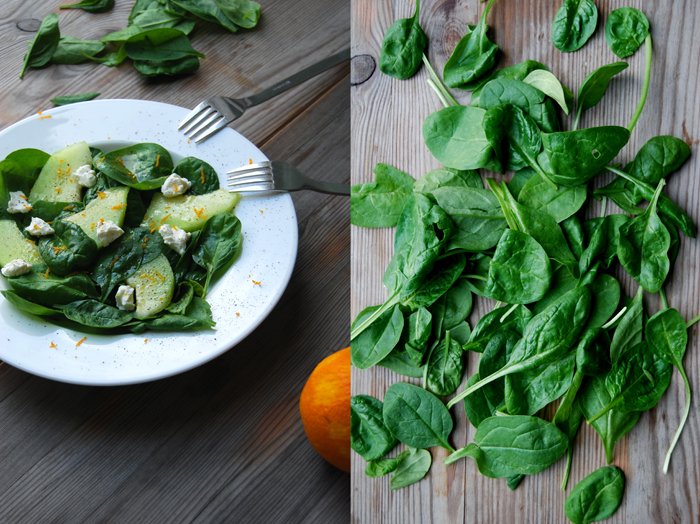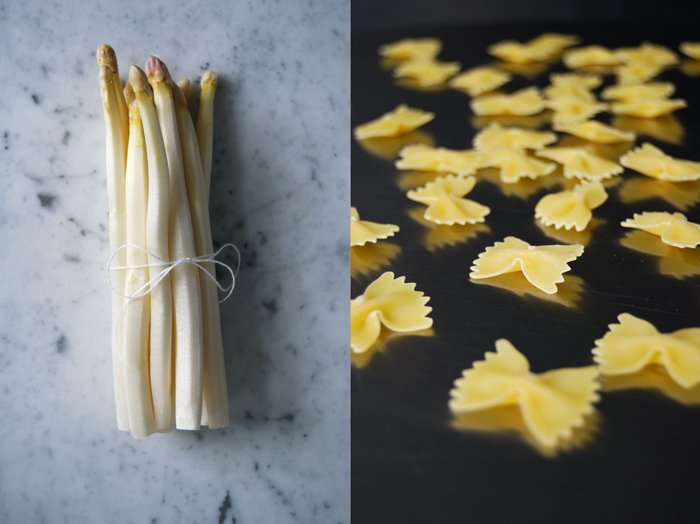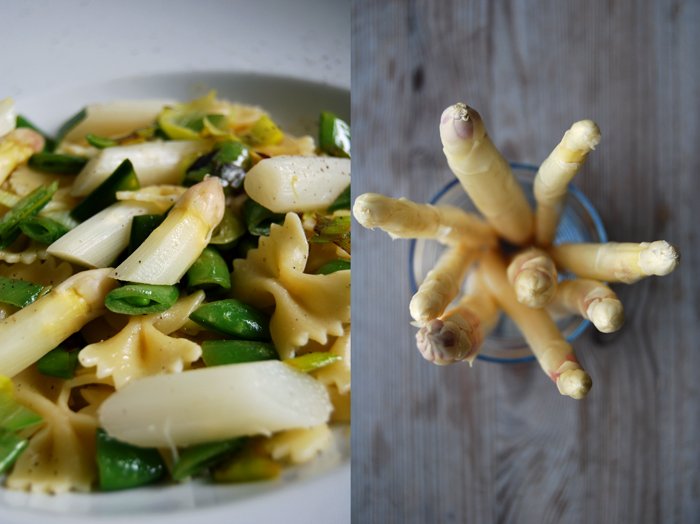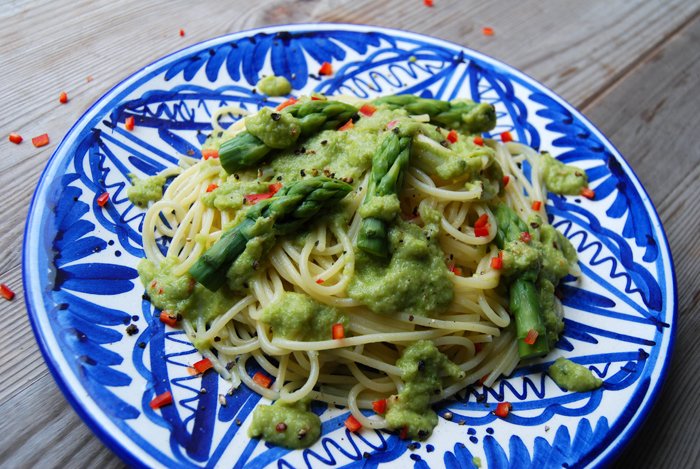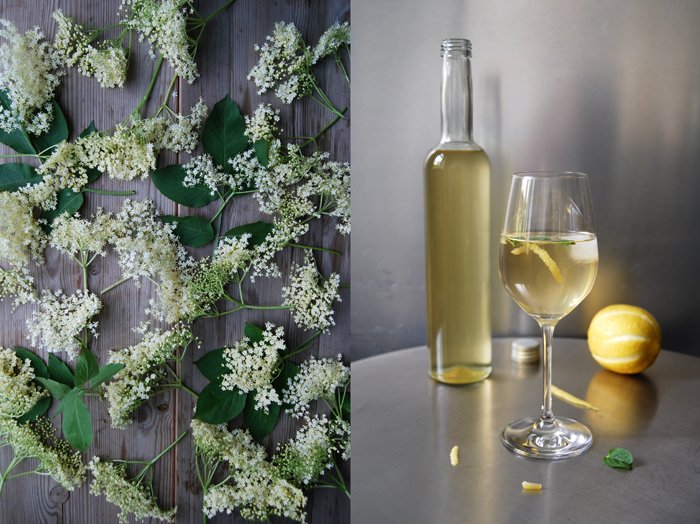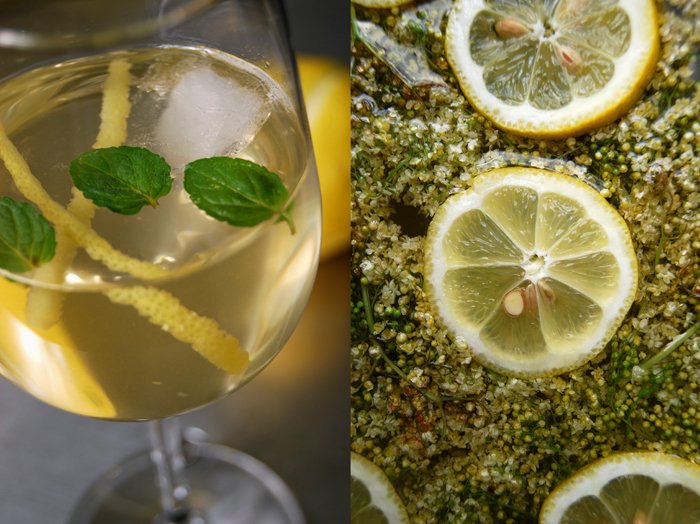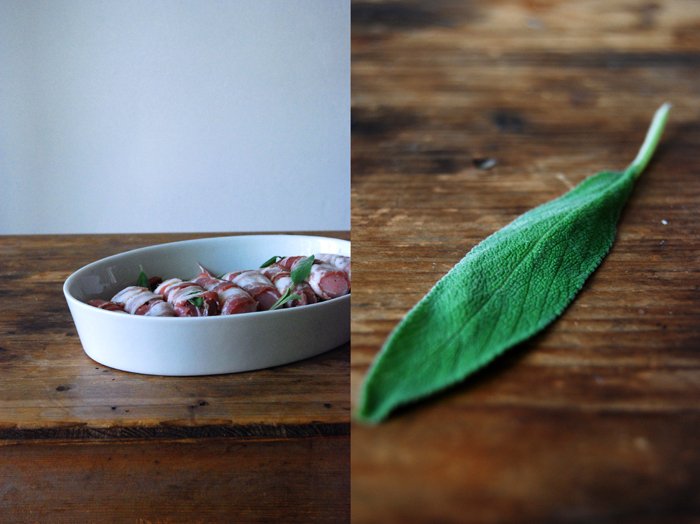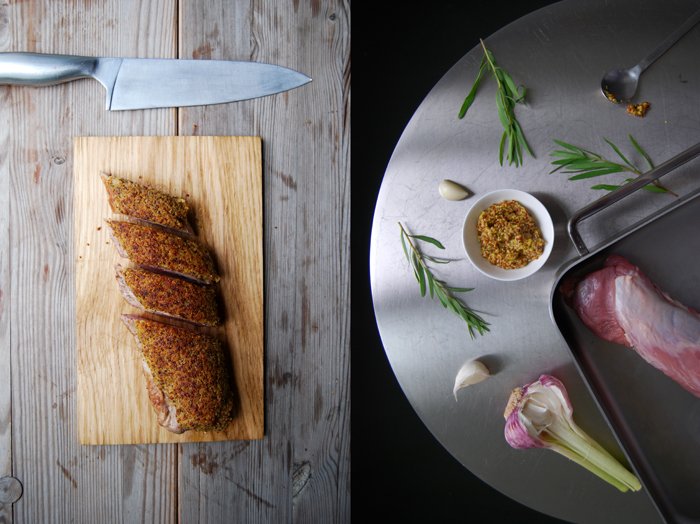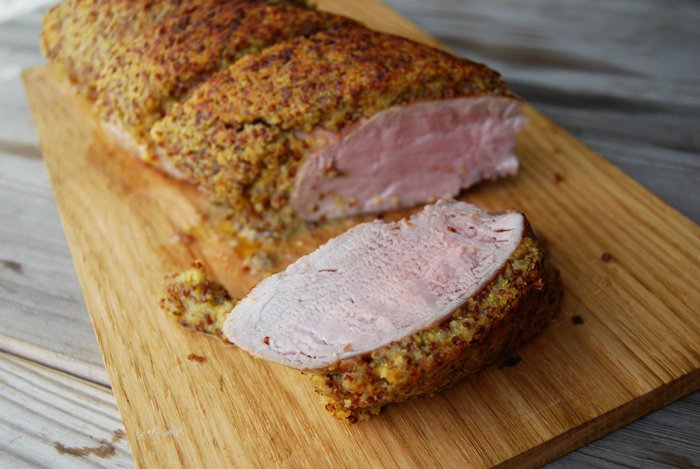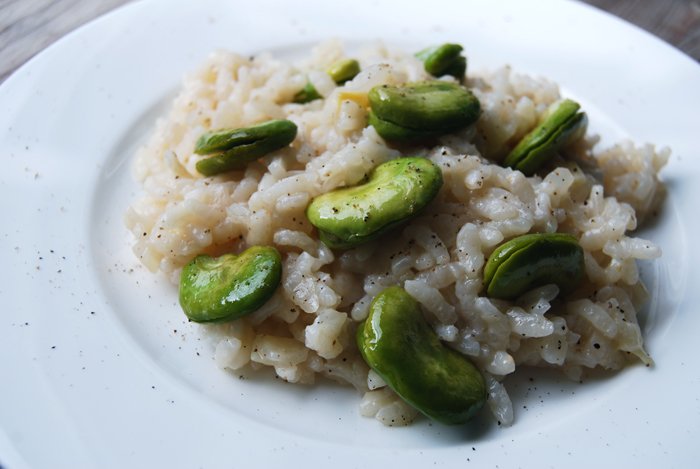Tomato Soup with Goat Cheese Nocken
A few weeks ago I received one of my mother's recipe faxes again. The list of her culinary adventures and recommendations was long (as always) and included Tyrolean Nocken made of goat cream cheese mixed with finely chopped hard mountain cheese. Nocken are dumplings, they can be made of potatoes like Italian gnocchi, bread or flour but there is also an uncooked version in which case they are made of cream cheese or ricotta. I've made these a couple times but never mixed with hard cheese. This sounded interesting, especially because I've been wanting to make tomato soup for weeks which seemed like the perfect combination to me. The fruity soup, thick and sweet, refined with some strong goat milk and cheese flavours!
I slipped in some herbs as well, fresh basil for the tomatoes after the soup was done and chives for the Nocken. The soup is a strong concentrate of 2 pounds of tomatoes, chopped and cooked with skin and seeds for just 10 minutes. Some garlic rubbed with salt to a smooth paste, a tiny bit of broth, some vinegar and the basil, that's all it needed. Apart from the Nocken, which I scooped with a wet spoon, to place a white dot in the middle of a glowing red bowl!
I served the tomato soup warm, some prefer it cold but that's not really my thing.
Tomato Soup with Basil and Goat Cheese Nocken
For 2 people as a main or 4 as a starter you need
ripe tomatoes, chopped, 1 kg / 2 pounds
broth 125ml / 5 ounces
garlic 2 big cloves
balsamic vinegar 1 tablespoon plus more to taste
a pinch of sugar
fresh basil leaves, roughly chopped, a small handful
salt and pepper
olive oil for frying
For the Nocken
fresh goat cream cheese 125g / 4.5 ounces
hard mountain cheese (like Appenzeller or Gruyère), finely chopped, 20g / 1 ounce
chives, snipped, 1-2 tablespoons
salt and pepper
Rub the garlic with 1/4 teaspoon of salt under a big knife to a smooth paste.
In a big pot, heat a splash of olive oil, add the garlic paste and tomatoes and cook for 4 minutes on medium temperature (open). Add the broth, vinegar, sugar, salt and pepper and cook for 5 minutes (open). Take off the heat and purée with a stick mixer or in a blender. Season with salt, pepper and vinegar to taste and stir in the basil.
Mix the goat cream cheese, hard mountain cheese and chives, season with salt and pepper to taste. With a wet tablespoon form oval Nocken and place on top of the soup. Serve immediately.
Spinach and Melon Salad with Orange Mascarpone
Crisp, young spinach leaves, sweet and ripe Galia melon, creamy mascarpone and a little orange zest becomes a delicious sweet and savory summer salad! It sounds a bit more exotic than it tastes, it's a very fresh and harmonious combination. The idea for it was born out of another recipe which didn't work out as I had expected. I felt like a salad made with melon and a milky flavour. At first, I mixed the melon with mozzarella di bufala but the result wasn't quite as pleasing as expected so I looked for another possible use for my juicy fruit. Spinach, mascarpone and orange, my second attempt was more successful and finally I was satisfied with my salad.
I just wanted a quick and light lunch so I spread a big handful of young spinach leaves on 2 plates together with a quarter Galia melon cut into wedges. I mixed 2 tablespoons of mascarpone with a little freshly squeezed orange juice and dolloped little pieces of it on top of the salad. For the dressing I whisked 5 teaspoons of olive oil with 3 teaspoons of orange juice, 2 teaspoons of balsamic vinegar and a little salt and pepper. I sprinkled the dressing on top of the leaves and fruit and finished it off with 1/2 a teaspoon of orange zest.
Sometimes you have to give your ideas a second try, change them a little but then you'll be rewarded. It definitely won't be the last time I make this salad!
Sole Meunière with a Mediterranean Tomato Confit
I went out to buy meat and came home with fish. The displays in the shops and markets have a huge effect on my shopping, often even more than my shopping list! A very fresh looking sole from the Atlantic caught my attention and I changed my mind, we'll have fish on the table instead! Sole caught in spring, in May and June is supposed to be the best, its taste is finer than during the rest of the year. This one is my first in 2014 and I gave it a Mediterranean twist. Tomatoes, black olives, capers, basil, garlic and a little freshly squeezed orange juice, these are the ingredients for my Mediterranean sauce, a thick and fruity tomato confit.
To fry a whole fish can be a bit intimidating, especially when it's as big as my sole, 650g (1.5 pounds) can be fiddly to flip around. I have a non-stick fish frying pan, a very convenient gift from my mother, which makes it much easier as its shape allows the fish to cook evenly. As long as your frying pan is big enough any other shape will do as well, I prefer non-stick as it needs less fat.
My sole is cooked whole, à la meunière coated in a thin layer of seasoned flour. The flour gave the recipe its name, meunière means miller's wife in French. I sautée the fish on high temperature in lots of olive oil and butter for just 3 minutes on each side. To prevent the fish from sticking to the bottom I shake the pan several times. There's a point of excitement involved in this recipe, and that's turning the fish. You should always do it quick and with confidence, I did it with my fingers pulling the fish up from its fin. Some use 2 spatulas or even another pan which I think is not necessary, just be brave and it will work!
Sole Meunière with a Mediterranean Tomato Confit
For 2 people you need
sole (whole), cleaned, rinsed and dried, 650g / 23 ounces (or 2 small ones)
plain flour for dusting
medium sized tomatoes, diced, 4
garlic, thinly sliced, 1 big clove
black olives, chopped, 4
capers, rinsed, 10
balsamic vinegar 1 teaspoon plus more to taste
freshly squeezed orange juice 1 tablespoon plus more to taste
salt and pepper
olive oil for frying
butter 1-2 tablespoons
For the tomato confit, heat a splash of olive oil in a sauce pan on a medium heat and cook the tomatoes and garlic for 2 minutes. Add the olives, capers, Balsamico vinegar, orange juice, salt and pepper and cook for 5 minutes (uncovered) or until thick and soft. Season with vinegar, orange juice, salt and pepper to taste.
On a large plate, season the flour with a little salt and pepper, toss the fish in, dust on both sides and shake off any excess.
In a large frying pan, heat a splash of olive oil and the butter on a high temperature and cook the fish for 3 minutes, shaking the pan 3-4 times. I cooked the white side first, some prefer to start with the dark side. Turn the fish with 1-2 spatulas (or from the fin like I did) and cook for 3 minutes on the other side until golden. If your fish is much smaller fry it for 2 minutes on each side only. Serve immediately.
A Greek Feta Dip with Harissa and Cayenne Pepper on Saffron Bread
The Greek stand at the market pokes my weak spot for spreads and nibbles. Bowls full of stuffed vine leaves, bean salad, olives, dips and feta cheese in all kinds of variations, I could always buy a box of each of these delicacies and line them up on my long dining table. Together with some fluffy flatbread and a glass of red wine, this is as good as a holiday!
As much as I enjoy the convenience of just going there and choosing whatever my taste buds feel like, I also like to make my own feta dip with herbs, spices or olives. This time I go for a spicy spread with harissa, cayenne pepper and some fresh red chili peppers. It's accompanied by my wonderful loaf of saffron bread which I baked especially for this dip as I know and love its sandwich qualities. This yellow spice is strong but not overpowering and always manages to bring in its special flavour. The bread is very aromatic, spongy, juicy, it's so good that it doesn't really need a topping, some olive oil sprinkled on top is already heavenly. I could have left it at that but I like the combination of saffron and harissa, there wouldn't be a better bread for my dip, not even a greek flatbread from the market.
Tomorrow I will share the recipe for the saffron bread with you but here's my Greek feta dip with harissa and cayenne pepper (which tastes as good on any other tasty, fresh bread):
Mix 200g / 7 ounces of Greek feta cheese crumbled with a fork with 100g / 3.5 ounces of cream cheese, 4 tablespoons of olive oil and 1 tablespoon of heavy cream. Add 2 teaspoons of dry harissa spice mix and a pinch of cayenne pepper (or more if you like it hot and spicy) and whip with a fork. I didn't add any salt as the cheese makes it salty enough. Sprinkle with finely chopped fresh red chili pepper and some olive oil and spread voluptuously on a thick slice of bread. This dip is enough for 4 people as a starter, the 2 of us emptied the bowl in 2 days. It would be great for a picnic or barbecue as well!
Farfalle with Asparagus, Peas and Leek in Mustard Sauce
This is one of my oldest, most beloved and often cooked spring/ summer recipes. It's been with me for so many years and I still savour it as I did the first time I cooked it. It works both warm as a comfy pasta dinner with a glass of rosé wine, the windows wide open and the flowery smell of June in the air but also as a cold, summery picnic salad, enjoyed outside in the fields under the rustling leaves of a swaying tree.
I'm talking about the wonderful combination of the fine flavours of white asparagus together with sweet peas in their crunchy pods, leek and a light sauce made with spicy Dijon mustard. All this on top of a big bowl of pretty Farfalle pasta, little bow-ties of perfect size and shape to catch all these nice vegetables like a shovel!
This meal tastes fresh and light and is absolutely easy to prepare. You just need to cook the asparagus (green or white), sautée the young pea pods and leek (you could also blanch some peas), deglaze them with white wine or vermouth and mix everything together with the cooked pasta, some mustard and cooking liquid, salt and pepper - that's it!
Farfalle with Asparagus, Peas and Leek in Mustard Sauce
For 2 people you need
Farfalle pasta, 200g / 7 ounces
asparagus (white or green), peeled (if necessary), bottoms cut off, 500g / 1 pound
young peas in their pods, cut into bite sized pieces, 150g / 5.5 ounces
leek, cut into slices, 1/2
water used to cook the asparagus 150ml / 5 ounces
Dijon mustard 2 teaspoons plus more to taste
white wine or vermouth for deglazing
salt and pepper
olive oil for frying
Cook the pasta al dente in lots of salted water.
Cook the asparagus al dente in lots of salted water with a pinch of sugar and cut into bite sized pieces.
In a large heavy pan, heat a splash of olive oil and fry the leek for a few minutes until soft and golden, add the pea pods and fry for another 1-2 minutes. Deglaze with a splash of wine, add the pasta, mustard and water used to cook the asparagus. Season with salt and pepper, add the cooked asparagus, mix and serve on big plates.
Juicy Zucchini Steaks with Dried Tomatoes, Sage and Chèvre
When I went to the market on Saturday I bought one of my favourite goat cheeses from a tiny stand run by a sweet lady who produces her own cheese. She just uses goat milk for her products and her display offers delicious soft chèvre rolls and creamy cheese balls coated in spices and herbs, with chili, herbes de provence, rosemary and basil. These soft cheeses are her absolute speciality, mild and milky with a soft hint of goat milk.
I planned to buy a plain cheese roll but a beautiful white chèvre covered in parsley leaves and pansy flowers caught my attention. The lady explained to me that it's filled with dried tomatoes, I was currious and forgot about my plain cheese immediately. I tried it, liked it and bought it! My plans for dinner involved golden sautéed zucchini cut into thick round steaks, juicy inside but far away from soft and soggy, topped with fresh goat cheese and sage. My find at the market inspired me to add some dried tomatoes, it was a good choice, the Mediterranean flavours were great together with the mild goat milk!
Zucchini Steaks with Dried Tomatoes, Sage and Chèvre
For 2 people you need
zucchini, cut into 1,5cm / 1/2" steaks, 300g / 10.5 ounces
garlic, thinly sliced, 1 clove
chèvre/ soft goat cheese, thickly sliced, 70g / 2.5 ounces
dried tomatoes, cooked in a little boiling water for 1 min, rinsed, dried and chopped, 1 1/2 -2
sage leaves, thinly sliced, 5
olive oil for frying
salt and pepper
In a large pan, heat a splash of olive oil together with the garlic and fry the zucchini on high-medium temperature for a few minutes until golden brown on each side. Add the cooked dried tomatoes and sage, season with salt and pepper and fry for 1 minute. On a plate, pile the zucchini steaks on top of each other and let them sit for 1 minute, that makes them a bit softer and juicy. Spread them on a big plate and place the chèvre on top of the warm zucchini and sprinkle with the dried tomatoes and sage from the pan.
Frankfurt Green Sauce - 7 Herbs and Spring Potatoes
Sorrel, borage, chervil, burnet, parsley, chives and garden cress, these are the 7 herbs which make up the traditional Frankfurt Green Sauce. Similar to the Italian Salsa Verde or the French Sauce Verte, which are also mainly made of herbs, the famous German version is made of greens growing in the Frankfurt area. Legend has it that the origin of the green herbal sauce is in the Orient and it was brought to Europe by the Romans more than 2000 years ago, enough time for each region to create their own, unique recipes. Apart from the right selection of herbs, there isn't "one" recipe for this sauce from Frankfurt. They all vary, some add heavy cream, sour cream, yoghurt or mayonnaise, some are made with onions, garlic or mustard, but most involve a hard boiled egg.
I developed my own recipe a few years ago when I used to live close to the city of the sauce's origin. To me, the sauce needs 2 crumbled hard boiled eggs, sour cream, olive oil, lemon juice, a little heavy cream for some sweetness, white Balsamico vinegar and salt and pepper, but the focus is definitely on the herbs, you need a lot, 200g / 7 ounces in total!
Traditionally the cold sauce is eaten with boiled spring potatoes, some serve it with cold meat but I prefer to keep it simple and light, the sauce is so fragrant and aromatic that the mild potatoes fit just perfectly.
Frankfurt Green Sauce with Spring Potatoes
For 2-3 people you need
medium sized potatoes, boiled and peeled, 4-6
For the sauce
mixed herbs (sorrel, borage, chervil, burnet, parsley, chives and garden cress) 200g / 7 ounces
organic eggs, hardboiled, chopped finely, 2
sour cream 5 tablespoons
olive oil 2 tablespoons
freshly squeezed lemon juice 2 tablespoons
heavy cream 1 tablespoon
white balsamic vinegar 1 tablespoon
salt and pepper
Chop the herbs with a knife finely or mix in a blender. Put the herbs in a big bowl and add the eggs, sour cream, heavy cream, olive oil, lemon juice and vinegar and stir until combined. Season with salt and pepper to taste and serve on top of the potatoes.
Lemon-spiced Chicken Wings with Cumin, Harissa and Mint Yoghurt
Chicken wings are often underestimated, unfortunately. Their tasty meat is packed in between the bones which keeps it juicy and due to the short roasting time it doesn't dry out. There isn't much meat on the wings which is an advantage to me as I prefer a small portion of meat especially when it's getting closer to summer and the temperatures rise. It's definitely enough for a spicy treat together with some aromatic cumin, harissa, lemon juice and a few slices of my Moroccan preserved lemons (which you could replace with lemon zest).
The spices and lemon made a delicious skin, golden and crisp after 20 minutes in the oven and packed with wonderful aromas. I like to eat the wings with my fingers, to feel their sticky juices and dip them in a refreshing sauce of yoghurt, sour cream, lemon and mint.
You could also throw them on the grill which would add some smoky flavours or take them out with you on a summery picnic. It's almost June and my mood calls for an early summer picnic with friends and lots of pots and plates of delicious food, so one dish is already sorted!
Lemon-spiced Chicken Wings with Cumin, Harissa and Mint Yoghurt
For 2 people as a main you need (we had half for lunch)
chicken wings 8
olive oil 4 tablespoons
freshly squeezed lemon juice 2 tablespoons
ground cumin 1 teaspoon
harissa 1 teaspoon
black peppercorns, crushed, 10
preserved lemon, sliced, 1/4 (or lemon zest 1 teaspoon)
coarse sea salt
For the yoghurt dip
yoghurt 4 tablespoons
sour cream 2 tablespoons
freshly squeezed lemon juice to taste
mint leaves, chopped, 10
salt and pepper
Set the oven to 210°C / 410°F top / bottom heat.
Whisk the olive oil with the lemon juice, cumin, harissa and black pepper and stir in the slices of the preserved lemon or the lemon zest. Place the chicken wings in a baking dish or on a baking sheet and coat with the spice oil. Sprinkle with salt and roast for 20 minutes or until golden and crisp.
Mix the yoghurt, sour cream, lemon juice, mint, salt and pepper and whisk until creamy.
We ate this with a simple green salad on the side and some baguette to dip into the juices. The French bread was also great with the yoghurt dip although Naan bread would have been more authentic.
Kalamata Olive and Cottage Cheese Sandwich
Creamy cottage cheese mixed with dark purple Kalamata olives, garlic, herbs, Balsamico vinegar, that's what I had in mind when I started my sandwich preparations. My plan changed abruptly as soon as I stirred the chopped olives into the crumbly cottage cheese, I stopped turning the spoon before the oily black mixture blended into the creamy white, the contrast looked so beautiful! I tried some of this puristic spread and I was so impressed by its intensity and simplicity that I dropped everything. This combination is too good, Kalamata olives (to me, they are the best black olives in the world!) plus cottage cheese, no distraction, no further addition, just a few slices of fresh baguette and one parsley leaf on top, that's all it needs! This is the quickest and most simple recipe I've made so far for my Sandwich Wednesday and it's already one of my favourite sandwiches!
If you're looking for a quick snack, a picnic treat, an easy dinner or just a nibble with some crackers, pull out some cottage cheese (200g / 7 ounces) and mix briefly with 50g / 2 ounces (or more) of chopped Kalamata olives. You could use other black olives as well but the large Greek fruits from the Peloponnese region have a wonderful aroma, exactly what you need if you mix only two ingredients. I didn't want to over mix it, I only stirred it twice before I spread the cheese on tiny slices of baguette. The green fleshy parsley leaves on top finished it off and added a fresh taste to this composition. I loved it so much that I ate one slice after the other, it was just enough for 2!
Bean and Bacon Salad with White Balsamico and Lemon Thyme
There is something really satisfying about deglazing tiny, crunchy cubes of bacon with sweet Balsamico vinegar. Be it the white or the dark one, both coming from Modena, this vinegar merges with the oily bacon juices to a thick, sweet and sour syrup. It is very concentrated, a great dressing to glaze hearty and crunchy salads like beans and cabbage. A few spoons enrich the vegetables with the whole range of the vinegar's aroma together with the meat's smoky saltiness.
I like to use this dressing for my traditional Bavarian cabbage salad as it brings out a sweet smoothness in the strong cabbage. Today it refines my fava beans, crunchy and green, cooked in salted water for around 6 minutes until they were al dente and rinsed with cold water. I peeled the beans out of their transparent shells for this salad and added some lemon thyme, salt and pepper.
As always, there is lots of peeling involved when there are fava beans on the table, I had 130g / 4.5 ounces of peeled beans after I started with 700g / 1.5 pounds of the fleshy pods. It was enough for the 2 of us as a side dish. I fried 30g / 1 ounce of bacon cut into tiny cubes in a little olive oil for a few minutes until they were golden brown and crisp before I deglazed it with 25ml / 1 ounces of white Balamico vinegar. I scraped the bits and pieces off the bottom of the pan and poured the syrup and bacon over the beans immediately. It just needed a little salt as the bacon added quite a bit of saltiness to it, some ground black pepper and a few fresh leaves of my lemon thyme on top and the salad was done!
Zucchini, Bell Pepper and Aubergine Moussaka with Lemon Ricotta
My Moussaka, truth be told, is a fruity ratatouille baked with a fluffy lemon ricotta soufflé on top. The traditional Greek Moussaka is made with a Béchamel sauce which I'm not too fond of. I like this creamy sauce in my lasagna or cannelloni but that's it. The ricotta tastes much lighter, enhanced with lemon zest, nutmeg, parmesan and fresh basil, it gives this dish more of a summer feeling. Contrary to the Greek version, I kept mine vegetarian, there's no minced meat involved, just zucchini, bell pepper, tomatoes, red onions, lots of parsley and a velvety layer of fried aubergine slices in between the vegetables and the cheese. It stops the ricotta from running into the juicy ratatouille.
When I cook a ratatouille I always make a big batch. This moussaka is perfect as a second day dish for ratatouille leftovers. Topped with the ricotta it just has to bake in the oven for half an hour, great if you have friend's over for dinner and not much time for preparations! I baked it in small casserole dishes closed with a lid so that each of us could have our own little pot.
Zucchini, Bell Pepper and Aubergine Moussaka with Lemon Ricotta
I bake the Moussaka in two 12,5cm / 5" casserole dishes with lids, you could use a big one instead but you may have to bake it a bit longer for the ricotta to set.
For 2-3 people you need
small aubergine, sliced into circles, 1
zucchini, sliced into circles, 1
red bell pepper, thinly sliced, 1
big red onion, quartered and thinly sliced, 1
big tomatoes, chopped, 4
garlic, thinly sliced, 3 cloves
parsley, chopped, 2 tablespoons
balsamic vinegar 2 tablespoons plus more to taste
olive oil for frying
salt and black pepper
For the topping
ricotta 260g / 9 ounces
organic eggs 2
Parmesan, grated, 30g / 1 ounce
small basil leaves, chopped, 30
lemon zest 1 teaspoon
lemon juice 1 teaspoon plus more to taste (I also added a little of the liquid of my Moroccan preserved lemons)
nutmeg, ground
salt and pepper
Spread the slices of aubergine on a baking dish and sprinkle with salt on both sides to pull some of its water out. Let it sit for around 15 minutes, rinse the slices and dry between kitchen roll paper. In a large heavy pan, heat a splash of olive oil and fry the aubergine for a few minutes on both sides on medium temperature until golden and soft, add a little more oil if necessary. Season with salt and pepper and set aside.
In a large pot, heat a splash of olive oil and fry the onion for a few minutes until golden and soft. Add the bell pepper and garlic and fry for 2 minutes before you add the zucchini. Fry the vegetables for 2-3 minutes and deglaze with 2 tablespoons of balsamic vinegar. Add the tomatoes, season with salt and pepper and cook for 10 minutes. Add the parsley and season with balsamic vinegar, salt and pepper to taste.For the topping, mix the ricotta, eggs, parmesan, basil, lemon zest and juice and season with nutmeg, salt and pepper to taste.
Set the oven to 200°C / 390°F top/ bottom heat.
Divide the vegetables between the 2 casserole dishes, cover with 3-4 slices of aubergine and spread the ricotta mixture gently on top. Cover with lids and bake for around 35 minutes until the ricotta mixture is set.
Spaghetti with Green Asparagus Anchovy Pesto
Asparagus season could be extended for months if it were up to me! So many recipes bring out different sides of this vegetable, be it green or white asparagus, it's so versatile thanks to its strong taste.
So here’s an asparagus pesto, light and fresh with a smooth texture, almost velvety. The preparation is the same as the broccoli pesto I made in March, the cooked vegetables are mixed with some of the water they are cooked in. I added garlic, fresh hot chili peppers, tarragon (my herb of the month) and anchovies. The fish adds subtle saltiness, which really makes this composition complete. I once made this pesto without the fish as I had run out and it really wasn't as good. I use 4 anchovies for 500g (1 pound) of asparagus, I originally started with just 2 when I made it the first time. I thought they would be too strong for the pesto but sometimes in cooking you shouldn't be shy, being bold and brave is the key to success!
For more asparagus recipes, click here!
Spaghetti with Green Asparagus Pesto and Chili Peppers
For this meal it’s best to warm up the plates in the oven.
For 2 hungry people you need
spaghetti 200g / 7 ounces
green asparagus, the woody bottom part cut off, 500g / 1 pound
water used to cook the asparagus 30ml / 2 tablespoons
olive oil 60ml / 1/4 cup
freshly squeezed lemon juice 1 tablespoon
anchovy preserved in salt, rinsed and dried, 4 fillets
garlic, crushed, 3 cloves
tarragon 12 leaves
fresh red chili pepper, finely chopped, 1, half for the pesto the rest for topping
salt and pepper
Cook the spaghetti al dente.
In a large pot, cook the asparagus in lots of salted water for 7 minutes. Keep the water, take the asparagus out with a slotted ladle and cut into 3cm / 1″ pieces. Set the heads aside and leave for the topping.
Purée all the ingredients for the pesto in a blender (except the asparagus' heads and the chili peppers for the topping). Season with salt (carefully, I didn't need to add any because of the salty fish), pepper and lemon juice to taste.
Arrange the spaghetti, pesto and asparagus' heads on the warm plates and sprinkle with chili and crushed black pepper.
Elderflower Syrup and a Friday Hugo Cocktail
It's Friday, the weekend is near, the perfect day for a summery cocktail! I don't need something frilly, I prefer simple and light drinks like a Hugo. This fruity long drink is from the Tyrolean region, it is originally made with sparkling wine but I like it with fruity white wine. The drink is mixed with elderflower syrup, mint leaves and lemon peel, all ingredients I find in my fridge or on the balcony apart from the syrup and this had to change! Not only does it make a nice cocktail it's also deliciously refreshing in a glass of sparkling water with a slice of lemon, for those hot summer days ahead of us! That's reason enough to make my own syrup.
I jumped on my bike, went to the park and came home with 25 big elderflowers. They just started to blossom here last week, I noticed their sweet smell as I was jogging. I've been wanting to try this recipe by my mother for years, she has been making her own syrup since she first tried a Hugo. I was always too late to pick the flowers and didn't want to repeat this mistake again. When I came back home with the elderflowers I was stunned by their beauty which tends to fade into all the leaves and flowers in the park so I never gave them proper attention. Their smell is enchanting and they feel so fragile!
I rinsed them briefly before pouring hot water mixed with sugar and citric acid over them and then I had to be patient. They have to sit for 5 days, stirred once a day, they infuse the syrup slowly with their distinctive aroma.
Strained and bottled, I was happy about my work, and satisfied to be able to make a Hugo with my own elderflower syrup from now on!
For the syrup
For 2 bottles of elderflower syrup you need
fresh elderflower umbels, briefly rinsed, 25 (use the whole umbel, cut the thick green stem off, the white florets should have just opened)
granulated sugar 1kg / 2 pounds
water 1000ml / 2 pints
citric acid 30g / 1 ounce
organic lemon, thinly sliced, 1
In a large pot, bring the water to a boil and dissolve the sugar and citric acid in it. Place the elderflower umbels in a large ceramic or glass bowl (not metal!), pour the hot water over them and put the lemon slices on top. Cover with a tea towel and let it sit for 5-6 days at room temperature, stirring once a day.
Sterilize glass bottles with spirit.
When the syrup is done, strain it through a cotton or linen kitchen towel and bring it to a boil. Strain through a towel a second time and fill in your sterilized bottles. Close well and put in your pantry. The syrup will last at least a year at room temperature, open bottles should be stored in the fridge.
For the Hugo cocktail
Fill a wine glass with sparkling wine or dry white wine. Pour in a dash of the elderflower syrup (to taste), add 1-2 ice cubes, stir and garnish with 2-3 strips of lemon peel and 3 mint leaves.
Rabbit wrapped in Sage and Bacon roast on Rhubarb
Sweet and sour rhubarb, salty bacon and aromatic sage wrap my juicy pieces of rabbit in a delicious composition of spring flavours. You could use pork fillet in this recipe as well but I like rabbit meat, it's tenderness and unique taste. We often eat it when we're in Malta where rabbit is so popular that it became the national dish. Be it as a Mediterranean stew with olives, tomatoes and wine, often cooked together with pork for a stronger aroma, or in a pie, I've enjoyed some of the best rabbit meals on this island!
Rabbit meat isn't very challenging to cook as long as it's kept moist and not overcooked. The little packages of sage and bacon in my recipe infuse the meat with their flavours but also keep it juicy. The steaming rhubarb roasting under the meat has the same effect. Its juices add a fruity taste to the meat and make sure that it doesn't dry out while it's cooking.
Rabbit wrapped in Sage and Bacon roast on Rhubarb
For 4 people you need
rabbit, without bones, 500g / 1 pound for 8 portions (I bought rabbit back and legs, the fillets from the back were the easiest to prepare)
rhubarb, cut into 5cm / 2" pieces, 500g / 1 pound
granulated sugar 3 tablespoons
garlic, thinly sliced, 3 cloves
fresh sage 16 leaves
bacon 8 slices
white wine 75ml / 2.5 ounces
olive oil 2 tablespoons
salt and pepper
Set the oven to 210°C / 410°F. My oven has a Rotitherm roasting setting which works perfectly for this recipe.
Cover the bottom of a baking dish with the rhubarb mixed with sugar. Season with salt and pepper.
Divide the rabbit in 8 portions, season with salt and pepper and wrap each portion in a slice of bacon together with 2 leaves of sage and 3 slices of garlic. Place on top of the rhubarb and pour the wine and olive oil over it.
Bake in the oven for 20 minutes, pouring some of the juices over it from time to time. For the last 3 minutes sprinkle the bacon with some sugar.
Aïoli and Wild Herbs Sandwich
When I went to Ibiza for the first time I got absolutely hooked on aïoli, I ate it every single day! It's more than twenty years ago and I had just turned thirteen. I was so happy to spend some time with my best friend at her parent's holiday home, it felt exciting to be on this island which is so famous for its parties (which I couldn't join as I was still too young)! I especially enjoyed the nights out at all the amazing restaurants we visited together, I have always loved Spanish food, tapas and barbecues, but in those days I was particularly fond of Ibiza's traditional appetizer, fresh bread and aïoli. In Spain, people usually go to restaurants quite late, at 9 or 10 in the evening, by that time I was already starving. As soon as we sat down and a basket full of warm bread and a bowl of creamy aïoli was brought to the table, nothing could stop me from emptying both!
It took me a while to make my own aïoli, a few years ago we had friends over from Barcelona and they introduced me to the traditional dip's secrets. It's surprisingly quick and easy to prepare:
For 4 sandwiches you drop 2 egg yolks into a mug which should be just big enough for a stick mixer to fit in it. You mix 3 crushed cloves of garlic with 4 teaspoons of freshly squeezed lemon juice in one bowl, and measure 100ml / 3.5 ounces of good quality olive oil in another. Pour 1/4 of the oil onto the egg yolks and start mixing with the stick mixer, add more oil and the lemon garlic mixture, a little at a time, mixing constantly. When the dip is thick and creamy season with salt. Spread on 4 thick slices of white bread and sprinkle with mixed wild herbs. I found a fantastic mixture of wild herbs which I don't use often, saltbush (orache), burnet, rucola, pigweed, edible chrysanthemum, yarrow, cheeseweed and chickweed. Every bite brought in new flavours, all strong and delicious together with the aïoli!
A warm Salad with Artichokes in Vermouth
Artichokes seem to follow me in the past few weeks, even when I don't buy them they end up in my kitchen. I got a bag full of beautiful purple baby artichokes as a gift, the tiniest I've ever seen. A friend of mine had bought too many and knowing that I use everything that finds its way into my space she was happy to pass them over to me. I had already made plans for dinner but the vegetables couldn't wait a day longer. When I looked at them, a warm salad came to my mind, a little snack in between. I imagined them sautéed and deglazed with vermouth and some parsley on top, so I brought out my pan and started the cooker.
As a starter for 4 you need 6 small baby artichokes. Cut off the artichoke stem if it’s too woody and pluck the hard outer leaves. Cut the artichoke’s tip off (1/3 – 1/2 of the artichoke), quarter them and scoop out the hairy choke. Keep the prepared artichokes in a bowl of cold water and the juice of half a lemon while you’re finishing the rest.
Sautée the prepared artichokes in a large heavy pan in a dash of olive oil and 2 tablespoons of butter for about 5 minutes together with 1 thinly sliced clove of garlic. Deglaze with 75ml / 2.5 ounces of vermouth and season with salt and pepper. Add 75ml / 2.5 ounces of water and 1 tablespoon of freshly squeezed lemon juice and let them simmer on a medium heat for about 10 minutes until al dente. Sprinkle with roughly chopped parsley and season with salt and pepper to taste.
Gratin with Cauliflower and Garlic Mashed Potatoes
This is a recipe my father used to make for us when we were children. We all loved it because of the cheese and mashed potatoes! I still do as it's one of the few dishes made with cauliflower that I really like.
When I wrote about my ginger, lemon and cauliflower soup I mentioned that I don't use this pretty white cabbage so often in my kitchen, I only like it in a few combinations. I don't have anything against its unique taste, it just needs the right treatment to bring out its sweet side. The mashed potatoes are a good choice, seasoned with nutmeg which I also use for the cauliflower to refine its taste, they are a good match. I didn't want to disturb the mild flavours in the gratin so I picked a soft cheese for the crunchy crust, not too ripe and overpowering. I used a hard Gouda, this Dutch cheese melts well and develops a nice crust under the grill, it's also the cheese my father used for this meal.
This recipe is very simple to prepare, a whole cauliflower cooked in one piece, pushed into creamy mashed potatoes and baked with cheese to a golden gratin. If you need a quick dinner for a handful of people, this is the perfect choice!
Gratin with Cauliflower and Garlic Mashed Potatoes
For 4 people you need
a whole cauliflower, around 700g / 25 ounces
potatoes, peeled, 650g / 23 ounces
garlic, in its skin, 3 big cloves
milk 200ml / 7 ounces
butter 50g / 2 ounces
nutmeg, freshly ground
salt and black pepper
hard cheese (Gouda, Emmentaler or cheddar), thinly sliced, 100g / 3.5 ounces
Cook the potatoes together with the garlic in salted water for 20 minutes. Rinse the potatoes under cold water for a few seconds and peel the garlic. Mash the potatoes together with the garlic, milk and butter, whisk and season with salt, pepper and nutmeg to taste.
Cook the cauliflower in lots of salted water al dente (around 10 minutes), it should be soft with bite without falling apart.
Scrape the mashed potatoes into a baking dish, put the cauliflower on top and push it down. Season the cabbage with salt, pepper and nutmeg and cover it with the cheese. Bake under the grill for a few minutes until golden brown, bubbly and crisp, slice like a cake and serve immediately.
A Field in the Forest, Beelitz and Asparagus Soup
A couple weeks ago I had a conversation about asparagus with my aunt and uncle, we talked about the various tastes depending on the vegetable's origin. The soil, the climate and weather have such a big influence on these delicate stems. I've enjoyed great asparagus in my life, green and white, but we agreed that the best is from Beelitz, an area 50 km (30 miles) outside Berlin. I always wanted to visit to see the large fields covered in foil keeping them dark, to watch the harvest and buy my asparagus directly from one of the farmers.
It's May, the seasonal peak for asparagus and there's no time to wait any longer! A few days ago we got on a train heading South-West to search for the famous Beelitz asparagus fields. We took our bikes with us to explore some of the quiet and hidden corners of the countryside, the forest and the fields and I can say that we found what we were looking for, asparagus heaven!
We got off the train at a tiny station, an old timber framed house which seemed abandoned for years. We noticed that we were the only travelers on the platform, we were happy about that and enjoyed the silence. When you live in the city the absence of noise is one of the biggest luxuries! The early afternoon sun felt just right, soft and warm, we jumped on our bikes, excited to start our trip.
Beelitz is a small town, it's peaceful and pretty. Old brick houses line the narrow cobblestone streets, little trees along the pavements blossoming in bright pink, a perfect picture book scene. It didn't take us long to leave the town behind us. The world in front of us turned into a glowing green, majestic trees with fleshy leaves, lilacs blooming at every corner spreading their sweet scent. The grass on the wide meadows looked fresh and juicy. We crossed a river and filled our lungs with the cleanest air we smelled in months! We turned into a tiny path and met an old man gathering grass for his rabbits. We chatted for a little while before we continued our drive along endless fields, on hidden alleys and through lonesome forest.
After driving through a dark forest of pine and fir trees for about half an hour we noticed a sparkle in the distance. At that point we weren't even thinking about asparagus anymore, we just enjoyed the peace and quiet, but there it was, right in front of us in the middle of hundreds of trees, an endless field of asparagus!
To keep the vegetables in the dark, they are covered with white foil which reflects the sun and creates a surreal, glittering scene, it felt like being on the moon! In the evening, on our way back to the train station we saw the pickers coming to harvest, creating dark shadows in front of a blinding white in the spotlight of the sinking sun. It was beautiful!
Behind the fields we spotted a farmer who offered thick and juicy white asparagus, the freshest I've ever bought. I filled my basket with the clean white stems knowing that I would turn a few of them into a delicious asparagus soup!
Asparagus Soup
For 4 people you need
white asparagus, peeled, the bottoms cut off, 1kg / 2 pounds
a pinch of sugar
water used to cook the asparagus 900ml / 2 pints
heavy cream 100ml / 3.5 ounces
nutmeg, freshly ground
salt and black pepper
tarragon, around 30 leaves for the topping
In a large pot, bring lots of water to a boil, add a pinch of sugar and salt and cook the asparagus for 20 minutes. Keep the water, take the asparagus out with a slotted ladle and cut into 3cm / 1" pieces. Set the heads aside and leave for the topping.
Bring 900ml / 2 pints of the water used to cook the asparagus to a boil and cook together with the cream on a medium heat for 5 minutes. Add the asparagus and purée with a stick mixer or in a blender. Season with salt, pepper and nutmeg to taste and serve in deep bowls sprinkled with the asparagus' heads and tarragon leaves.
Pork Fillet with a Grainy Dijon Mustard and Tarragon Crust
I don't need meat on my table often, once a week is enough for me, but on some days my hunger needs more than just vegetables. This week I got hooked on a nice piece of pork fillet which when properly prepared is uncomplicated, juicy and also great as a leftover meal. I bought a whole 600g (1.5 pounds) of fillet knowing that it would be a bit much for the two of us but we were happy to enjoy it the next day, cold cuts at its best!
Pork fillets are always delicious in combination with herbs, with sage for example, you could wrap the meat in prosciutto similar to a Saltimbocca alla Romana but I felt like mustard, a spicy, grainy mustard crust enhanced with the flavours of tarragon. When I make a crust, I like a thick, slightly crunchy cover on the meat, concentrated and strong. The classic Dijon mustard with its fine spiciness would work as well but the rougher, grainy one makes a better crust. Dijon mustard's history goes back to 1856, when Jean Naigeon of Dijon first substituted verjuice (the acidic juice of unripe grapes) for the normal vinegar.
Sometimes, meat dishes are quicker and easier to prepare than vegetarian meals, this is one of them. I mixed the ingredients for the crust in a blender, fried the meat and baked everything in the oven for just 15 minutes. After frying the meat, I deglazed what was left in the pan with vermouth which turned into a thick juice. The meat didn't really need a sauce but it was nice to dip it into this concentrated syrup.
Pork Fillet with Mustard and Tarragon Crust
For 4 people you need
pork fillet, one piece of 600g / 21 ounces
butter 40g / 1.5 ounces
dry breadcrumbs 20g / 3/4 ounce
whole-grain Dijon mustard 3 heaping tablespoons
garlic, crushed, 1 clove
tarragon, chopped, 14 leaves
salt and pepper
olive oil for frying
vermouth, 150ml / 5 ounces
Set the oven to 200°C / 390°F (top/ bottom heat).
Mix the butter, bread crumbs, mustard, garlic and tarragon in a blender and season with salt and pepper. Roll out the paste between 2 layers of cling film, it should have roughly the shape as the pork fillet.
In a large heavy pan, heat a splash of olive oil on high temperature and fry the meat seasoned with salt and pepper for a few minutes until golden brown on all sides. Take the meat out of the pan and deglaze the bits and pieces left in the pan with the vermouth. Let it cook for 30 seconds, season with salt and pepper and take off the heat.
Put the meat into a baking dish, cover with the mustard butter paste and press it softly onto the meat. Bake in the oven for 12 minutes, switch to grill function and let the crust turn brown and crisp for 3 minutes.
Serve the meat in thick slices with a few drops of the thick concentrated vermouth sauce.
Parmesan Risotto with crisp Fava Beans
When my sister told me abut her latest risotto discovery from her trip to Italy, she sounded so thrilled that I couldn't wait to get the pot on the cooker. She was talking about a parmesan risotto which by itself isn't necessarily spectacular but this one is different. It's made with bigger pieces of cheese which are stirred into the creamy rice when the risotto is done. The parmesan melts, partly, but a few crumbs keep their crunchy center which makes it taste stronger, more concentrated. I was absolutely impressed, this method of preparation lifts parmesan risotto onto another level!
I had some fava beans left on my window sill which I added to the rice, I prefer to have some vegetables with my risotto. Be it a simple salad or some sautéed greens on the side, I need my vitamins as much as my carbohydrates! I fried the beans with some garlic, deglazed them with white wine and let them simmer for a few minutes. I wanted them al dente, a crisp topping for my smooth risotto!
I cooked the risotto with the water I had used to cook asparagus in a few days ago. It's a light broth which I always keep and freeze, great for recipes which need a soft vegetable aroma.
Parmesan Risotto with Fava Beans
For 4-5 people you need
Arborio rice 400g / 15 ounces
medium size onion, chopped finely, 2
broth around 2200ml / 4.5 pints
Parmesan, cut into 1cm / 1/2" cubes, 80g / 3 ounces
fava beans, peeled out of their pods and shells, 800g / 28 ounces (around 300g / 10.5 ounces peeled beans)
garlic, roughly chopped, 1 clove
white wine 120ml / 4 ounces
salt and black pepper
olive oil for frying
butter 2 tablespoons
In a large pan, heat a little olive oil and 1 tablespoon of butter, add the garlic and beans and fry on a medium heat for a few minutes until golden. Deglaze with half of the wine and let it cook for a minute. Season with salt and pepper and add the rest of the wine, close with a large lid and let it simmer for 5 minutes or until al dente. Season with salt and pepper to taste.
In a large pot, fry the onions in a little olive oil and 1 tablespoon of butter until golden and soft, stir in the rice and fry on a medium heat for a minute. Add some of the broth, the rice should be covered, stir and turn the heat down to medium-low. When the liquid has been absorbed add more broth, a little at a time stirring in between. Depending on the rice, it needs more or less liquid. When the rice is al dente and the broth is more or less absorbed take it off the heat, season with salt and pepper to taste and stir in the Parmesan, close with a lid and let it sit for a minute. Arrange on plates together with the fava beans.









